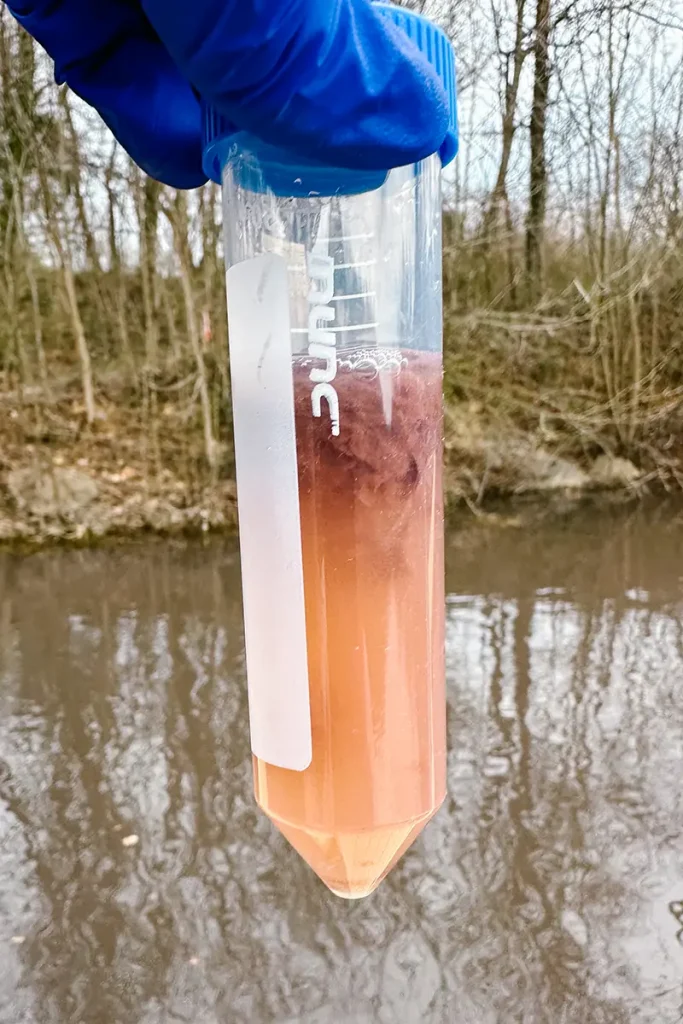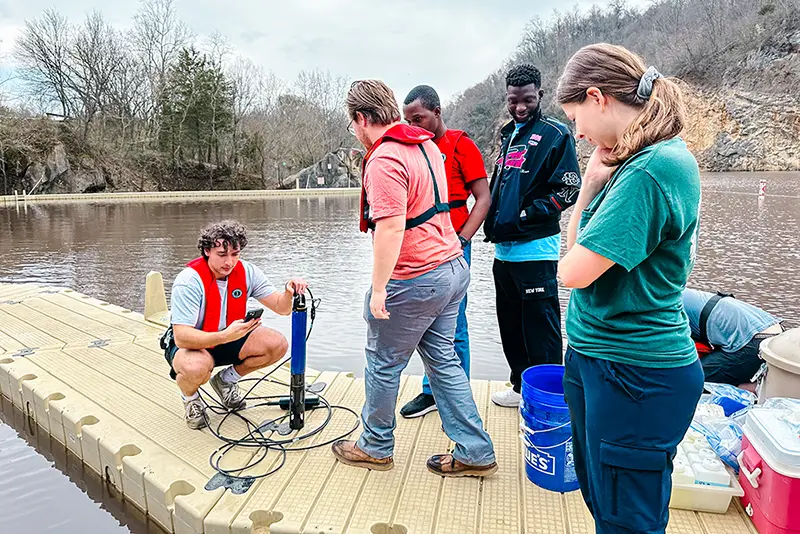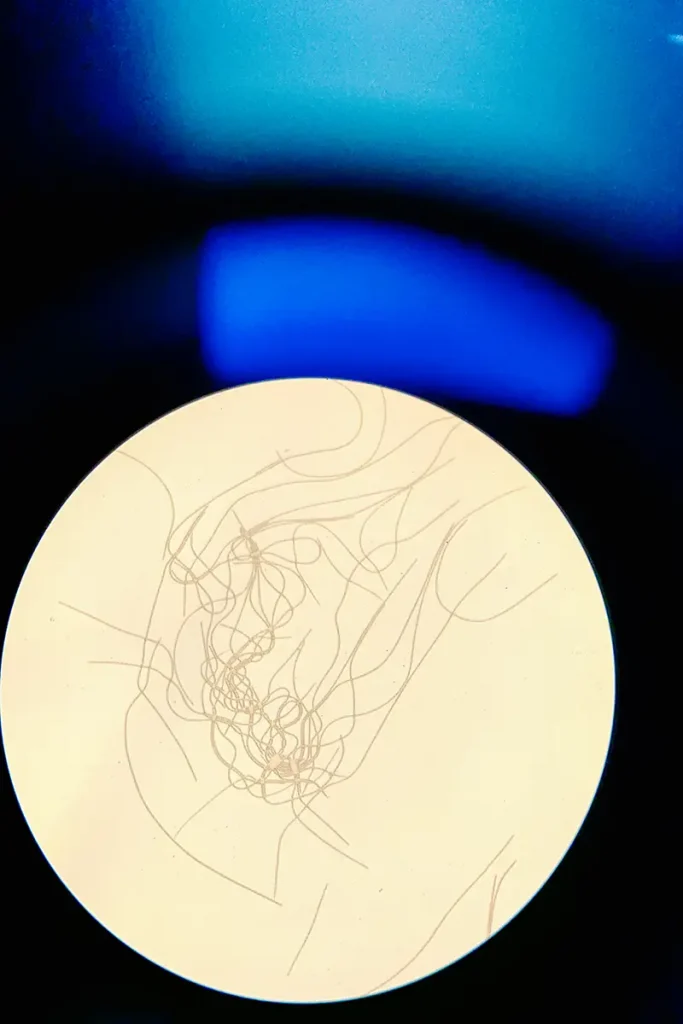Mead’s Quarry Research Reveals Toxic Algae Drivers
UT research into a pink algae bloom that closed the popular swimming area at Ijams Nature Center in 2024 is providing insight into how the organisms thrive.

Researchers from the University of Tennessee, Knoxville, who quantified high toxin levels during a 2024 pink algae bloom at Mead’s Quarry Lake have published a new study identifying the potential causes.
Their findings, based on the algae’s genetic and chemical composition, will be in the January 2026 issue of the journal Harmful Algae.
Previously much of the research into harmful algal blooms has focused on light and agricultural nutrients such as nitrogen and phosphorus that are washed into aquatic systems.
“The algal genera that was blooming in this quarry was a bit of an enigma,” said the lead author, Brittany N. Zepernick (PhD ’23). “The water temperature was cold, the light penetrating into the water column was low, and our results suggested the algae weren’t using the nitrogen that was abundant throughout the water column.”
The researchers found that the alga blooming in Mead’s Quarry was capable of growing on alternative nitrogen sources such as urea. “We have seen this in the Laurentian Great Lakes before but never suspected it in a small local waterway,” said Steven Wilhelm, the Kenneth and Blaire Mossman Professor in the Department of Microbiology and one of the co-authors.
Microbiologists and chemists collaborated on the research, using techniques ranging from small molecular analyses by mass spectrometry to genomics to classic tools of limnology.
Understanding how the algae processes various forms of nitrogen—including urea and arginine—ultimately may help predict and prevent harmful blooms.
Classroom to Fieldwork

Zepernick was leading a UT Advanced Techniques in Field Microbiology course in spring 2024 when the graduate students in microbiology and chemistry collected samples at Mead’s Quarry Lake.
Analysis showed the algae that was turning the quarry pink possessed toxin-producing genes and had used them to synthesize elevated levels of microcystins, a liver toxin.
UT already had a working relationship with Ijams Nature Center President/CEO Amber Parker, and Zepernick immediately contacted her when testing showed high levels of microcystins. Ijams issued a health advisory until the levels decreased.
Zepernick is now a postdoctoral research fellow at the University of North Carolina (UNC) but plans to continue collaborating with UT on the research in Knoxville when she starts her new faculty position in January 2026 at UNC Wilmington.
“We are planning to collect fresh samples from the quarry this spring in attempts to isolate the bloom former, Planktothrix rubescens,” Zepernick said. “This is no small feat, requiring a skilled hand chasing the microscopic filaments around with a tiny pipette tip and microscope or more sophisticated methods of isolation.” Some samples will be sent to the University of Wilmington Algal Resources Collection, which specializes in algal isolations.
Then the researchers will perform lab experiments to test which forms of nitrogen the alga prefers to consume and how this, in turn, affects growth and toxicity.
Leveraging Research

“UT is an amazing research level one (R1) institution that routinely conducts cutting-edge research supported by major funders like the NSF (National Science Foundation) and NIH (National Institutes of Health),” Zepernick said. “Yet, we often forget that research can also be leveraged in the classroom too—not just in our labs.”
At UT she was a member of the Southeastern Conference (SEC) Emerging Scholar Program, which included funding for professional development. “Through this opportunity I was able to provide the students with a humble research budget leveraged by contributions from the Great Lakes Center for Fresh Waters and Human Health,” Zepernick explained. “In this manner, seven graduate students and two volunteer teaching assistants were able to serve as real-world professionals to solve a community problem: What was turning Mead’s Quarry pink each spring?”
“You don’t always need a million-dollar grant and prestigious lab to conduct meaningful research,” she said. “Sometimes you just need a handful of dedicated graduate students, a few thousand dollars, and the support of your community, institution, and collaborators.” The Great Lakes Center for Fresh Waters and Human Health, supported by NSF and NIH, facilitates collaborations such as these.
Graduate students in the course were involved in every step of the process, from planning the experiment through analysis and synthesis. The interdisciplinary research team also allowed microbiology and chemistry students to learn techniques from each other.
UT has been researching how to protect water supplies from harmful algal blooms for more than a quarter of a century, and is part of a virtual center studying links between climate change, harmful algal blooms, and human health. Recent grants from the National Oceanic and Atmospheric Administration, NSF, and the Paul Allen Foundation support research into the environmental conditions and geochemistry driving different toxic bloom formers.
Wilhelm’s renown in the study of freshwater lakes and harmful algal blooms led Zepernick to first consider UT to pursue her doctoral degree. “I attended the interview weekend and was blown away by the caliber of research his lab was conducting, his various instruments, and the camaraderie and dedication of his students,” she said. “Beyond Steve’s lab, the microbiology department was incredibly supportive, and I knew UT was the institution I wanted to conduct my dissertation work at.”
By Amy Beth Miller